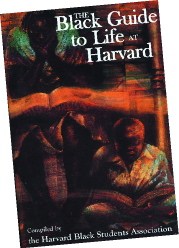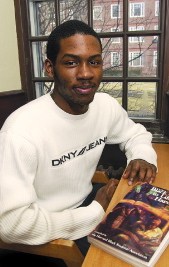 One year after the release of The Women's Guide to Harvard comes The Black Guide to Life at Harvard, compiled by the publications chairs of the Black Students Association (BSA), Kiratiana E. Freelon '02 and Marques J. Redd '04. (The Crimson reports that a Latino counterpart, La Vida at Harvard, will appear this autumn.)
One year after the release of The Women's Guide to Harvard comes The Black Guide to Life at Harvard, compiled by the publications chairs of the Black Students Association (BSA), Kiratiana E. Freelon '02 and Marques J. Redd '04. (The Crimson reports that a Latino counterpart, La Vida at Harvard, will appear this autumn.) In an introductory essay, Freelon and Redd sketch the 324-page Guide's ambition to provide "rich descriptions of Black history, powerful student reflections from the past, detailed information about the makeup of the present-day Black community," and practical information on local resources ranging from hair salons to churches. But they begin with a reference that ought to engage, and perhaps slightly disquiet, any member of the Harvard community: the autobiographical assessment of W.E.B. Du Bois, A.B. 1890, Ph.D. 1895, that "I was in Harvard, but not of it."
 |
| Marques J. Redd |
| Photograph by Stu Rosner |
The Guide, in effect, chronicles the Harvard century-plus from Du Bois to an era that has "awarded current students of color...the opportunity to be 'of' Harvard." Freelon and Redd write of the integration of "formerly all-white organizations such as the Hasty Pudding Club, the various final clubs, the Crimson, and the Glee Club;" the ascension of people of color to leadership positions such as class marshal and University Overseer; the arrival of "Black 'legacies'" among newly admitted students; and the rise of minority organizations, with their own new traditions, such as the South Asian Association's Ghungroo show or the Kuumba singers. Another sign of the times: commercial sponsors of and advertisers in the Guide include Boston Consulting Group, Morgan Stanley, and Banc of America Securities.
Illustrated timelines and essays depict the history of African Americans in Boston and the University, occasionally evoking from the recent past a vocabulary as well as memories that now seem ancient: a 1964 Crimson headline on "The Ivy League Negro: Black Nationalist," the 1970s protests advocating sale of Harvard holdings in Gulf Oil stock, Derrick Bell's campaign for a more diverse Law School faculty, the "Black & Crimson" guide for incoming freshmen.
The directory of undergraduate organizations numbers 16, from the Association of Black Harvard Women to the Harvard Society of Black Scientists and Engineers and Soul Food Bible Study. In the professional schools, the list includes groups focused on African business and governance, African-American healthcare, and more. Within the "Life at the Ebony Tower" section is a statistical profile of black students at the University (1,244, or 6 percent of the total enrollment), their College concentrations (economics ranks first), and family backgrounds. There are faculty and staff profiles, and student essays: Stephanie Wilford '84 describes her journey from inner-city Chicago to Harvard "I was not an 'incoming' freshman. I was an 'outlanding' alien from a different planet" and its outcome: "I've learned much about experiencing new things while watching Harvard experience me." And signs that the adjustments continue: from the list of the 10 stupidest things said to black women at Harvard, the prize at number two, "I know your struggle. I read Beloved." (A separate top-10 list, stemming from his personal dating issues and inserted by Redd, was found offensive by other BSA members, and has been removed from the Guide.)
The concluding section, on Cambridge and Boston resources, exudes possibilities and options beyond the already extensive student universe (how many undergraduates have dined at M&M Ribs in Dorchester?). And it is in that spirit that the editors solicit ideas and comments for improved future editions at bsa@hcs.harvard.edu.





